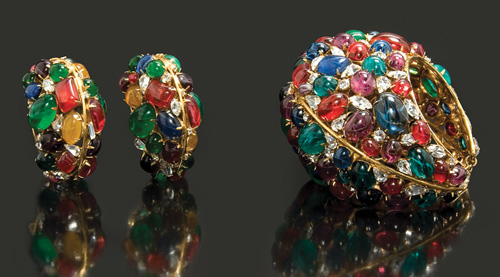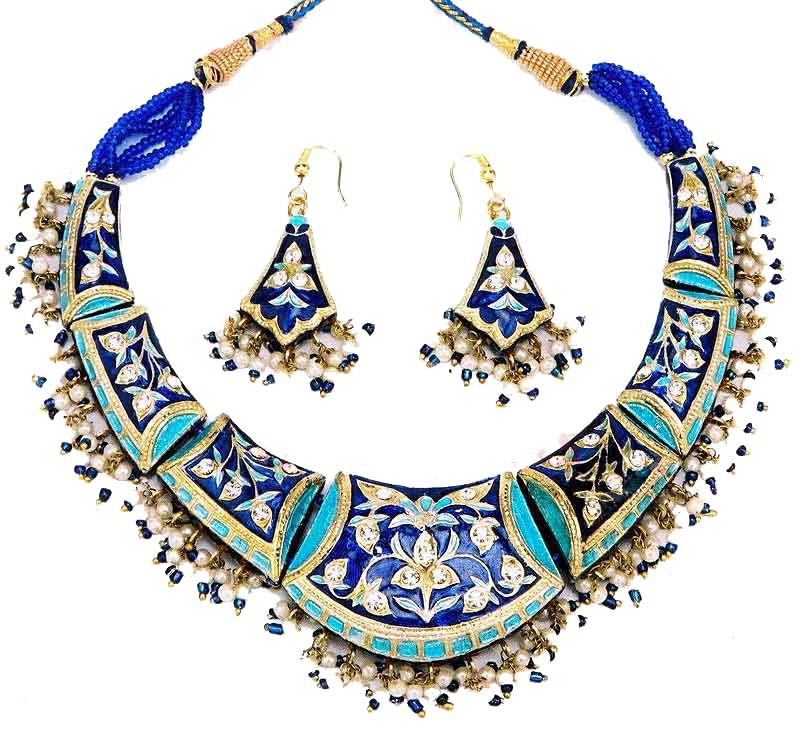Costume Jewellery Biography
Source
(google.com.pk)
Costume Jewelry
Adornments for the body that are made of precious metals and stones are called jewelry, and jewelry is given the name costume jewelry when it is not made from precious materials. Costume jewelry provides an inexpensive way to add glamour and sparkle to fashion because it is usually made of cheap materials, such as glass or plastic rather than diamonds and emeralds, and plain steel, brass, or copper, rather than gold and silver. Though costume jewelry has been worn during many periods, it had a major rise in popularity during the 1920s and 1930s.
For as long as people have worn jewelry made of precious stones and metals, they have also made false versions of that jewelry. Even ancient Greeks and Romans wore glass jewelry, which imitated the look of expensive precious stones. During the seventeenth and eighteenth centuries French and English jewelers worked to perfect new hard types of glass that could be cut to give the many-faceted look of a diamond. This glass was called paste, and paste became the name given to false jewels. Jewelry made of these paste jewels was usually called fashioned jewelry because the stones were made or fashioned by people.
During the early 1920s the creative French designer Gabrielle "Coco" Chanel (1883–1971) introduced many popular new styles. She moved away from the formal layers of clothing that had been popular during the 1800s, considering them old-fashioned and suffocating. Chanel's styles were simple, loose, and comfortable, and to dress them up with sparkle she designed a type of fashioned jewelry she named costume jewelry.
Chanel's costume jewelry was big and bold with long strings of glass beads, dangling earrings, and many plastic bracelets stacked up on the arms. The inexpensive flashy jewels fit right in with the sexy look of the 1920s flapper, or independent and rebellious woman, and soon costume jewelry adorned many stylish young women across the Western world. Other well-known designers, such as Elsa Schiaparelli (1896–1973) of Italy, began to design their own styles of costume jewelry.
The tremendous popularity of costume jewelry lasted through the 1930s, as many women imitated the glamour of Hollywood stars. Though women continue to buy costume jewelry as an inexpensive alternative to real jewelry into the twenty-first century, many of the costume pieces designed during the costume jewelry craze of the 1920s have become collectors' items, bringing prices almost as high as gold and diamonds.
Jewels were always part of human culture. Even from the times when humans first started using clothes and tools some 100.000 years ago, jewels were produced from any kind of materials that were available - stones, animal skins, feathers, plants, bones, shells, wood, and natural made semi-precious materials such as obsidian. As the time went on, advancing technology enabled artisans to start taming metals and precious gems into works of art that influenced entire cultures and many modern jewelry styles. However, even with all advancements of metallurgy and gem processing, the purpose of wearing jewelry always remained the same - they enabled wearer to express himself non-verbally, showcase wealth, rank, political and religious affiliation or affections toward someone. This enabled jewelry to become timeless and a target for constant development and refinement.
Development of early jewelry can be roughly divided across three ancient civilizations - Egypt, India and China. Egypt and Mesopotamia set standards in metallurgy, gem collecting, and glass manufacture. Their several thousand year long tradition of jewelry production laid a solid foundation for all European civilizations that came after them, and their unique style affected fashion trends even four thousand years later.
India however managed to develop such a connection to jewelry that it became integral part of their daily life and religion. Since they were the first who managed to conquer the art of gold gathering and processing, they develop art of jewel making much earlier than anyone in their environment. This made them one of the most sought destinations for trade, which eventually became driving force for the incredible expansion of European civilization during the Age of Discovery. On the far side of the world, China managed to become driving force in developing of arts and their influence slowly spread their unique style across entire Asia. Chinese style that is focused on scenes of nature, animals and dragons is today still in high popularity, and continues to be developed with each passing year.
After the fall of Ancient Egypt and Roman Empire, Europe became driving force of jewelry innovation. However, it took a long time until they managed to claim that position. After almost thousand years of isolation, famine, plagues and wars, Western Europe finally came into contact with distant civilizations during Crusades which enabled flow of new knowledge an ideas that enabled birth of Renaissance. As transfer of wealth from nobility, royalty and church continued to flow to middle classes during Renaissance, Age of Discovery and Industrial Revolution, jewelry designs and fashion trends changed dramatically. During those times world saw the appearance and disappearance of many styles, some new and original and some based on older designs found in the ruins of long gone civilizations (mostly Egyptian, which became one of the inspirations of Romanticism and Art Deco).
After more than 100.000 years of use of decorative items, and more than 6 thousand years of metallurgy and gem processing, we can surely say that jewels will forever remain integral part of humanity and our entire civilization
Jewels were always part of human culture. Even from the times when humans first started using clothes and tools some 100.000 years ago, jewels were produced from any kind of materials that were available - stones, animal skins, feathers, plants, bones, shells, wood, and natural made semi-precious materials such as obsidian. As the time went on, advancing technology enabled artisans to start taming metals and precious gems into works of art that influenced entire cultures and many modern jewelry styles. However, even with all advancements of metallurgy and gem processing, the purpose of wearing jewelry always remained the same - they enabled wearer to express himself non-verbally, showcase wealth, rank, political and religious affiliation or affections toward someone. This enabled jewelry to become timeless and a target for constant development and refinement.
Development of early jewelry can be roughly divided across three ancient civilizations - Egypt, India and China. Egypt and Mesopotamia set standards in metallurgy, gem collecting, and glass manufacture. Their several thousand year long tradition of jewelry production laid a solid foundation for all European civilizations that came after them, and their unique style affected fashion trends even four thousand years later.
India however managed to develop such a connection to jewelry that it became integral part of their daily life and religion. Since they were the first who managed to conquer the art of gold gathering and processing, they develop art of jewel making much earlier than anyone in their environment. This made them one of the most sought destinations for trade, which eventually became driving force for the incredible expansion of European civilization during the Age of Discovery. On the far side of the world, China managed to become driving force in developing of arts and their influence slowly spread their unique style across entire Asia. Chinese style that is focused on scenes of nature, animals and dragons is today still in high popularity, and continues to be developed with each passing year.
After the fall of Ancient Egypt and Roman Empire, Europe became driving force of jewelry innovation. However, it took a long time until they managed to claim that position. After almost thousand years of isolation, famine, plagues and wars, Western Europe finally came into contact with distant civilizations during Crusades which enabled flow of new knowledge an ideas that enabled birth of Renaissance. As transfer of wealth from nobility, royalty and church continued to flow to middle classes during Renaissance, Age of Discovery and Industrial Revolution, jewelry designs and fashion trends changed dramatically. During those times world saw the appearance and disappearance of many styles, some new and original and some based on older designs found in the ruins of long gone civilizations (mostly Egyptian, which became one of the inspirations of Romanticism and Art Deco).
After more than 100.000 years of use of decorative items, and more than 6 thousand years of metallurgy and gem processing, we can surely say that jewels will forever remain integral part of humanity and our entire civilization
Costume Jewellery Indian Jewelry Sets Bangles Rings Box Designs Band Designs Lates Gold Earnings Designs Ads Photos Images Pics

Costume Jewellery Indian Jewelry Sets Bangles Rings Box Designs Band Designs Lates Gold Earnings Designs Ads Photos Images Pics

Costume Jewellery Indian Jewelry Sets Bangles Rings Box Designs Band Designs Lates Gold Earnings Designs Ads Photos Images Pics

Costume Jewellery Indian Jewelry Sets Bangles Rings Box Designs Band Designs Lates Gold Earnings Designs Ads Photos Images Pics

Costume Jewellery Indian Jewelry Sets Bangles Rings Box Designs Band Designs Lates Gold Earnings Designs Ads Photos Images Pics

Costume Jewellery Indian Jewelry Sets Bangles Rings Box Designs Band Designs Lates Gold Earnings Designs Ads Photos Images Pics

Costume Jewellery Indian Jewelry Sets Bangles Rings Box Designs Band Designs Lates Gold Earnings Designs Ads Photos Images Pics

Costume Jewellery Indian Jewelry Sets Bangles Rings Box Designs Band Designs Lates Gold Earnings Designs Ads Photos Images Pics

Costume Jewellery Indian Jewelry Sets Bangles Rings Box Designs Band Designs Lates Gold Earnings Designs Ads Photos Images Pics
_300_bC.jpg)
Costume Jewellery Indian Jewelry Sets Bangles Rings Box Designs Band Designs Lates Gold Earnings Designs Ads Photos Images Pics

ReplyDeleteThe selection varies from jeweler to jeweler. Some may carry generic jewelry, common designs you'll see in most stores and are divided mostly by price, be it from tag price or how far they're going to discount. Most jewelers carry some designer jewelry brands and watch companies. Again this selection is set by price point and target market.
jewelers In Charleston SC